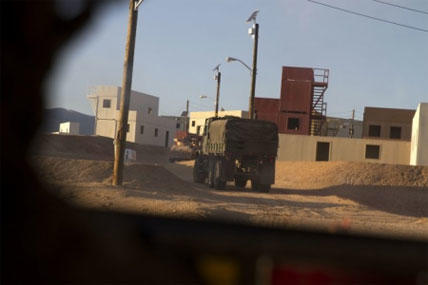MARINE CORPS AIR GROUND COMBAT CENTER TWENTYNINE PALMS, Calif. - Training for Marines is critical in developing and maintaining skills needed for a safe and successful missions, whether it is a training exercise or a deployment to a combat zone.
Marines with Truck Support Company, Combat Logistics Battalion 5, conducted convoy training in support of Exercise Steel Knight 2015. The annual exercise includes elements from I Marine Expeditionary Force. The exercise focused on conventional operations and provided realistic training that prepares the Marines for overseas operations.
Training prior to a deployment is equally as important as training during one. Sustainment training ensures the skills and discipline learned before a deployment is attained and honed before serving in a dangerous environment.
“One of the biggest things we want to prevent is complacency,” said 2nd Lt. Christopher Antle, the 1st platoon commander for Truck Support Co. “Just because they have been done this before, doesn’t mean they can stop training. They need to practice the new tactics, techniques and procedures that are sent down the chain on a constant basis.”
The training consisted of a convoy of six vehicles, two seven-ton trucks and four Humvees. The vehicles traveled in a single file through a mock town overrun by another platoon of Marines who were acting as enemy soldiers.
During the scenario, one of the vehicles was hit by a rocket-propelled grenade while enemy soldiers fired at the convoy from the rooftops. The Marines in the convoy then had to repel the attack, gather any casualties and tow the damaged vehicle out of the town.
“The Marines did very well,” Antle said. “A lot of them have never done this before, but they stepped up and performed beyond the standard set for them.”
It was important for the Marines to learn each job inside the vehicle. If something happens to one Marine inside of a vehicle, another Marine will know what to do in his place.
“It’s crucial for Marines to know the roles of the other Marines with them,” said Cpl. Justin McGee, a motor transportation operator with Truck Support Co. “If something goes wrong, they will know their place and what is expected of them. Ideally, if Marines switch jobs after several convoys, they will know who is responsible for doing what, when to do it and how to do it, because they once had that position.”
After the training, the Marines conducted an after action report to discuss the training and the different scenarios: What happened, what was supposed to happen and suggestions for the future.
“I’d rather see them mess up just practicing because I know they will learn from it,” Antle said. “It’s a whole different story in a combat situation, but I have confidence in these Marines”
The Marines with CLB-5 continue to hone their craft to make their vehicles operational, keep timely and accurate fire on target, and most importantly protect the Marines on the battlefield. When the company comes together, they’ll prove they are a deadly force.




























